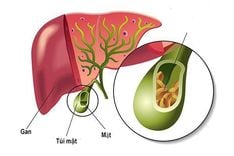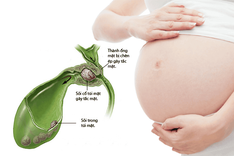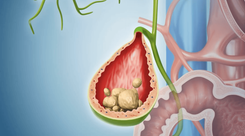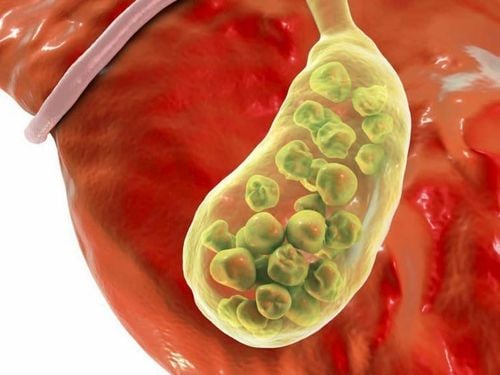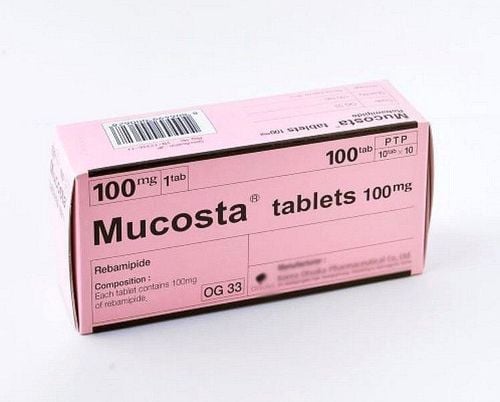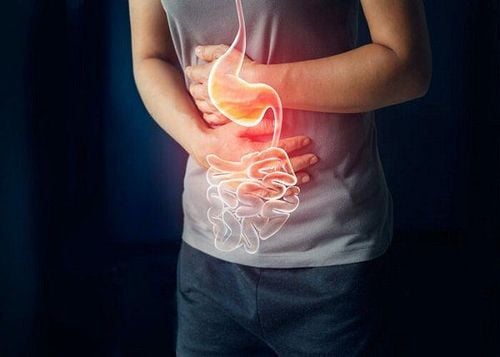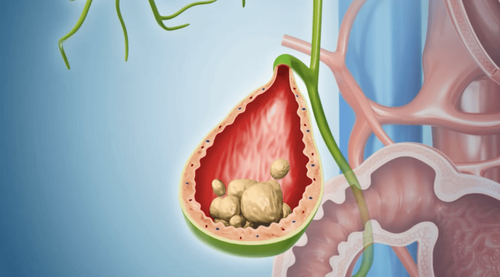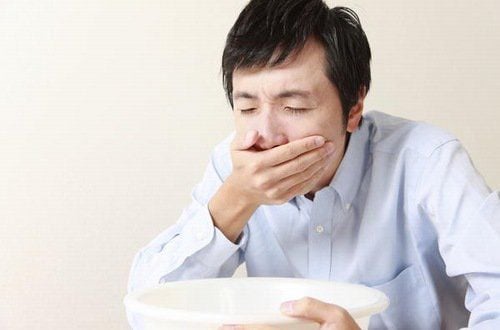Epigastric pain refers to pain in the upper abdominal area, located just above the navel and below the sternum (breastbone). This is a common symptom that can be caused by various digestive issues like gastritis, acid reflux, or stomach ulcers. Identifying the correct cause is essential for effective treatment and to prevent more serious complications. The article below explains some common causes and offers simple, practical advice on what to do when you experience epigastric pain.
1. Causes of epigastric pain
Epigastric pain is a common symptom often caused by digestive system issues. In most cases, it is related to stomach conditions such as gastroesophageal reflux disease (GERD), where acid from the stomach flows back into the esophagus, causing heartburn and discomfort. Another common cause is gastritis, which is inflammation of the stomach lining that leads to burning pain, nausea, or vomiting. Indigestion can also trigger epigastric pain, making you feel bloated, overly full, or uncomfortable after eating.
In some rare cases, epigastric pain can signal more serious conditions, such as gallbladder inflammation (cholecystitis), which often causes severe pain after eating fatty foods. Acute pancreatitis may also lead to intense, persistent pain that spreads to the back and is accompanied by nausea or vomiting. A heart attack can sometimes cause pain in the epigastric region, which might be mistaken for stomach pain but is often accompanied by symptoms like shortness of breath, dizziness, chest tightness, or fainting. If the pain is severe, lasts for several hours, or does not improve with basic remedies, it is essential to seek medical attention. Warning signs like shortness of breath, dizziness, chest pressure, or fainting require immediate emergency care. Besides that, epigastric pain can result from many causes, and only a doctor can provide an accurate diagnosis and appropriate treatment. Identifying the cause early ensures effective care and prevents potential complications.
1.1. Gastritis
Gastritis is inflammation of the stomach lining, which can cause epigastric pain ranging from mild to severe. The pain is often accompanied by a burning sensation, especially when you are hungry or after eating. Other symptoms include nausea, belching, bloating, and, in some cases, vomiting.
Gastritis can occur for several reasons, such as an unhealthy diet high in fried foods, stress, frequent use of anti-inflammatory medications, or infection with Helicobacter pylori bacteria.
What to Do for Epigastric Pain Caused by Gastritis: The treatment plan should be prescribed by a gastroenterologist. Doctors may recommend medications such as proton pump inhibitors (PPIs) like Omeprazole to reduce stomach acid production. If the patient is infected with H. pylori, antibiotics such as clarithromycin or amoxicillin may also be prescribed.
Additionally, it is essential to adjust your eating habits. Avoid alcohol and spicy foods to reduce irritation and promote healing of the stomach lining.
1.2. Esophagitis and Gastroesophageal Reflux Disease (GERD)
Esophagitis is inflammation of the esophageal lining, commonly caused by acid reflux or hiatal hernia. It leads to epigastric pain and a burning sensation in the chest, which worsens after meals or consumption of caffeine, alcohol, and fatty foods. Symptoms are often more severe at night.
Treatment for Epigastric Pain Due to Esophagitis: Doctors typically prescribe acid-reducing medications like omeprazole or famotidine. Lifestyle changes are crucial, including quitting smoking, avoiding alcohol, and limiting fatty, sugary, and processed foods. In severe cases, surgical intervention may be required to control reflux and relieve symptoms.
1.3. Indigestion
Indigestion occurs when the body struggles to digest food properly, which can result from:
Overeating.
Consuming foods the body cannot tolerate well.
Eating contaminated food.
Consuming lactose-containing foods.
These factors can irritate the stomach lining, trigger acid reflux, produce excess gas, and increase bowel movements. Symptoms include epigastric pain, bloating, diarrhea, or constipation.
What to Do for Epigastric Pain Caused by Indigestion: In most cases, the pain resolves within a few hours. You can take medications like antacids or pain relievers to reduce discomfort and drink plenty of water. Opt for foods that are gentle on the stomach, such as gelatin or dry crackers, to avoid further irritation.
1.4. Gallstones
Gallstones can cause severe abdominal pain, typically in the upper right quadrant, but some individuals may experience epigastric pain. The pain often starts suddenly and worsens quickly, accompanied by nausea and vomiting.
What to Do for Epigastric Pain Caused by Gallstones: A gastroenterologist may prescribe medications like ursodeoxycholic acid to dissolve the stones, along with pain relievers and anti-nausea medications to reduce discomfort. In some cases, gallbladder removal surgery (cholecystectomy) may be necessary. Lifestyle changes, such as reducing the intake of fatty foods and red meat, are also recommended to prevent further issues.
1.5. Acute pancreatitis
Acute pancreatitis is a sudden inflammation of the pancreas, causing intense pain that often radiates to the epigastric area, along with symptoms like nausea, vomiting, and bloating. The pain worsens after eating and can be debilitating.
What to Do for Epigastric Pain Caused by Acute Pancreatitis: This is a medical emergency that requires prompt treatment to prevent complications. Initial management includes fasting, IV fluids, and pain relievers. If infection is suspected, antibiotics like Ciprofloxacin or Vancomycin may be prescribed. In severe cases, surgery may be required to treat complications. Timely intervention is essential to reduce the risk of life-threatening outcomes.
1.6. Cardiovascular diseases
Cardiovascular conditions such as myocarditis or myocardial infarction (heart attack) can cause epigastric pain instead of the typical chest pain. Although rare, epigastric pain from a heart attack is often associated with a burning or squeezing sensation, nausea, vomiting, cold sweats, and shortness of breath.
Cardiovascular diseases are more likely in individuals with risk factors such as age, obesity, diabetes, high blood pressure, smoking, or a history of heart disease.
What to Do for Epigastric Pain Due to Cardiovascular Disease: If a heart attack is suspected, it is crucial to get immediate emergency care. Diagnostic tests may include an electrocardiogram (ECG) and troponin T levels. Treatment will depend on the patient's clinical condition and the severity of the heart attack. Early intervention is critical to improving outcomes and preventing complications
2. What to Do for Epigastric Pain?
2.1. Warm Compress
Applying a warm compress or hot water bottle to your stomach for 15-20 minutes can help relax tense muscles and reduce pain. Heat can also relieve indigestion and constipation by improving blood flow to the digestive area. A warm bath is also helpful, especially for pain caused by stress or tension.
2.2. Avoid Lying Flat
If you have epigastric pain from indigestion or bloating, lying flat can make it worse. When you sit up, gravity helps prevent acid reflux and allows gas to pass more easily, which can relieve discomfort.
2.3. Stay Hydrated
Sometimes, epigastric pain can be caused by dehydration. Drinking plenty of water throughout the day helps your digestive system work properly and may ease discomfort. Be sure to drink slowly, as rapid consumption can cause additional bloating or nausea.
2.4. Peppermint
Peppermint contains compounds that help relax muscles in the digestive tract, reduce inflammation, and relieve nausea. It can be consumed fresh, as tea, or in other forms. Peppermint oil is commonly used to reduce symptoms of irritable bowel syndrome (IBS) and improve digestion, easing stress-related stomach pain.
2.5. Cinnamon
Cinnamon has natural anti-inflammatory and antioxidant properties that support digestive health. It can help reduce bloating, relieve cramps, and calm inflammation in the stomach. Cinnamon has been used for thousands of years in traditional medicine and is recognized today for its ability to improve digestion and reduce discomfort.
These simple remedies can help ease epigastric pain. However, if symptoms persist or worsen, it is important to consult with a doctor for proper diagnosis and treatment.
Please dial HOTLINE for more information or register for an appointment HERE. Download MyVinmec app to make appointments faster and to manage your bookings easily.
